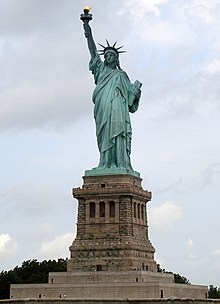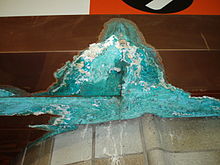Verdigris
| Verdigris | ||
|---|---|---|
| (67, 45, 187°) | ||
| Source | [1] | |
| ISCC–NBS descriptor | Brilliant bluish green | |
| B: Normalized to [0–255] (byte) | ||

Verdigris
History
Etymology
The name verdigris comes from the Middle English vertegrez, from the Old French verte grez. According to one view, it comes from vert d'aigre,[13] "green [made by action] of vinegar". The modern French writing of this word is vert-de-gris ("green of grey"), sounding like the older name verdet gris ("grey greenish"), itself a deformation of verte grez. It was used as a pigment in paintings and other art objects (as green color), mostly imported from Greece, and hence it is more usually given another etymology as vert-de-Grèce ("green of Greece").[14][15]
Production
Copper(II) acetate is prepared by treatment of
Chemical composition


Verdigris is a collective term for copper acetate, whose chemical varieties produce different hues. The technical literature is inconsistent in describing these variations. Some sources refer to "neutral verdigris" as
Overall, variations of verdigris can be divided into two groups: basic verdigris and neutral verdigris.[6]: 132 The difference in colour depends on the hydration level and degrees of basicity.[12]: 637
Toxicity
Verdigris, which was once used as a medicine[7][8] and pharmaceutical preparation
Uses

Verdigris is a naturally occurring protective layer on metals such as copper, brass, and bronze. In addition to be a desirable artistic effect, it has been used primarily as a pigment and now-outdated medicinal preparations.
Pigment
Verdigris has been used as a pigment since antiquity, including in paintings in Rome and Pompeii. The use of verdigris continued into the
: 132Stability
The art pigment verdigris is subject to colour change. The changes are most pronounced during the first month of exposure to air. The changes also depend on the type of
Verdigris pigment is lightfast in oil paint, as numerous examples of 15th-century paintings show. However, its lightfastness and air resistance are very low in other media. Copper resinate, made from verdigris by boiling it in a resin, is not lightfast, even in oil paint. In the presence of light and air, green copper resinate becomes stable brown copper oxide.[14] The browning mechanism is attributed to the transient formation of Cu(I) in the pigment and oil system. The reduction of Cu(II) into Cu(I) due to the release of a carboxylate, causes changes in the optical properties of pigment. Furthermore, linseed oil induces the transformation of the copper acetate bimetallic structure, and forms monomeric series. Dioxygen that reacts with partially decarboxylated dimers to form a peroxy-Cu dimer complex is responsible for the darkening of the pigment.[12]: 635–638
In previous literature on painting, verdigris has been described as unstable when combined with other pigments which leads to further deterioration. Due to the fickle nature of the pigment, it required special preparation of paint, carefully layered application, and immediate sealing with varnish to avoid rapid discoloration (but not in the case of oil paint).[14] However, further scientific research suggests that the difficulties are less extreme than previously described. The pigment nonetheless has the ability to degrade cellulosic materials, such as paper.[6]: 137 In terms of identification and reproduction, modern technology and reproducible synthesis procedures have been developed to be used for museums and collections to identify distinct verdigris phases in historical artworks.[23]: 14857 Certain components of historical verdigris pigments, copper(II) acetates, are partially irreproducible based on the given historical recipes.[23]: 14847
-
One of the earliest uses of verdigris as a pigment in painting; Last Supper (1306) by Giotto Di Bondone
-
Raphael used verdigris for the green coat of Saint John, the left angel's frock, and other accents, in The Mond Crucifixion
-
The Verdigris of the angels' costumes in Nativita Mistica byBotticellidarkened from bluish green to foliage green.
Medicine
Verdigris has also been used in medicine,: 176
See also
- Bronze disease
- Green pigments
- List of colors
- List of inorganic pigments
- Patina
References
- ^ "Its pronunciation in English is still unsettled" (Fowler's Dictionary of Modern English Usage (4 ed.) edited by: Jeremy Butterfield). The pronunciation /-ɡriːs/ is the first one given by Merriam-Webster's dictionary, but /-ɡriː/ is first in the Oxford Dictionary of English (3 ed.) (2015).
- ^ a b "Verdigris". Merriam-Webster.com Dictionary.
- ^ a b Karmakar, Rabindra N. (2015). Forensic medicine and toxicology: theory, oral & practical. Academic Publishers.
- ^ a b Anant, Jagdish Kumar, S. R. Inchulkar, and Sangeeta Bhagat (2018). "An overview of copper toxicity relevance to public health." EJPMR 5, no. 11 : 236.
- ^ ISSN 0140-6736.
- ^ a b c d e f g h H. Kühn, Verdigris and Copper Resinate, in Artists' Pigments. A Handbook of Their History and Characteristics, Vol. 2: A. Roy (Ed.) Oxford University Press 1993, p. 131 – 158
- ^ a b c d "Medical Uses of Copper in Antiquity". Copper Development Association. Retrieved 8 June 2014.
- ^ a b c d Paris, John Ayrton (1831). Pharmacologia. New York: W. E. Dean.
The rust of the spear of Telephus, mentioned in Homer as a cure for the wounds which that weapon inflicted, was probably Verdegris, and led to the discovery of its use as a surgical application
- ^ S2CID 112614238.
- ^ ISSN 0361-2317.
- ^ Verdigris, ColourLex
- ^ S2CID 253847558.
- ^ Dauthenay, Henri (1905). Répertoire de couleurs pour aider à la détermination des couleurs des fleurs, des feuillages et des fruits. Vol. 2. Paris: Librairie horticole. p. 240. RC2.
- ^ OCLC 936144129.
- ^ The Concise Oxford Dictionary of English Etymology, edited by T. F. Hoad (1996), and Merriam-Webster's dictionary give only this second etymology.
- ^ .
- ^ Darnton, Robert. "A Bourgeois Puts His World in Order" in The Great Cat Massacre --and other Episodes in French Cultural History. New York: Vintage Books, 1985. p. 114.
- ISBN 3527306730.
- ^ ISSN 0010-938X.
- ^ a b Sharp, D. W. A: Penguin Dictionary of Chemistry, page 419. Penguin Books, 1990 (2nd edition)
- .
- ^ Women and the Verdigris Industry in Montpellier, European Women and Preindustrial Craft. Project MUSE, Indiana University Press, 1995
- ^ PMID 29043336.
- ISBN 978-1-85709-442-8.
External links
- National Pollutant Inventory – Copper and compounds fact sheet
- Verdigris, ColourLex
- Making Pigments – Verdigris, Paul Grosse



